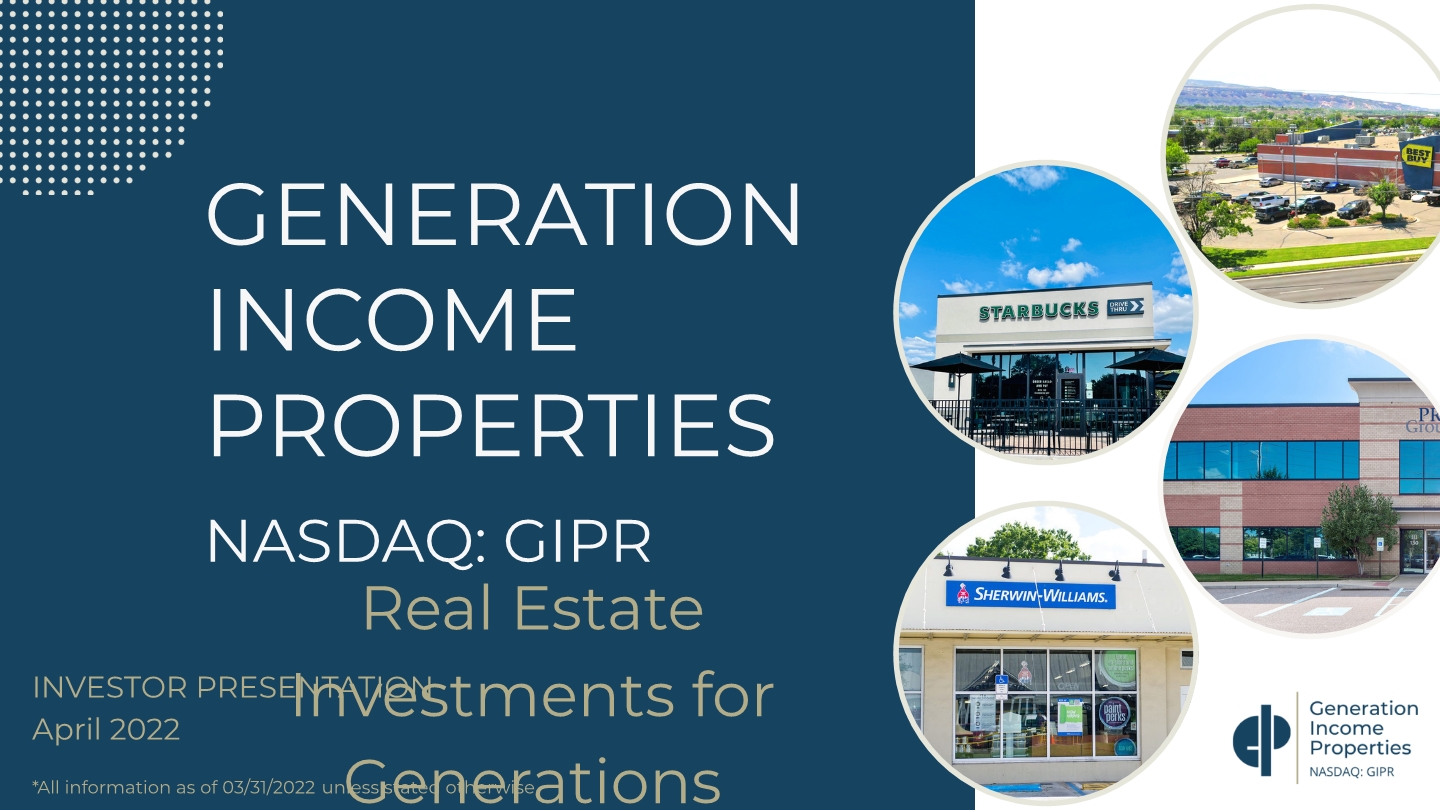

GENERATION INCOME PROPERTIES NASDAQ: GIPR INVESTOR PRESENTATION April 2022 *All information as of 03/31/2022 unless stated otherwise Real Estate Investments for Generations
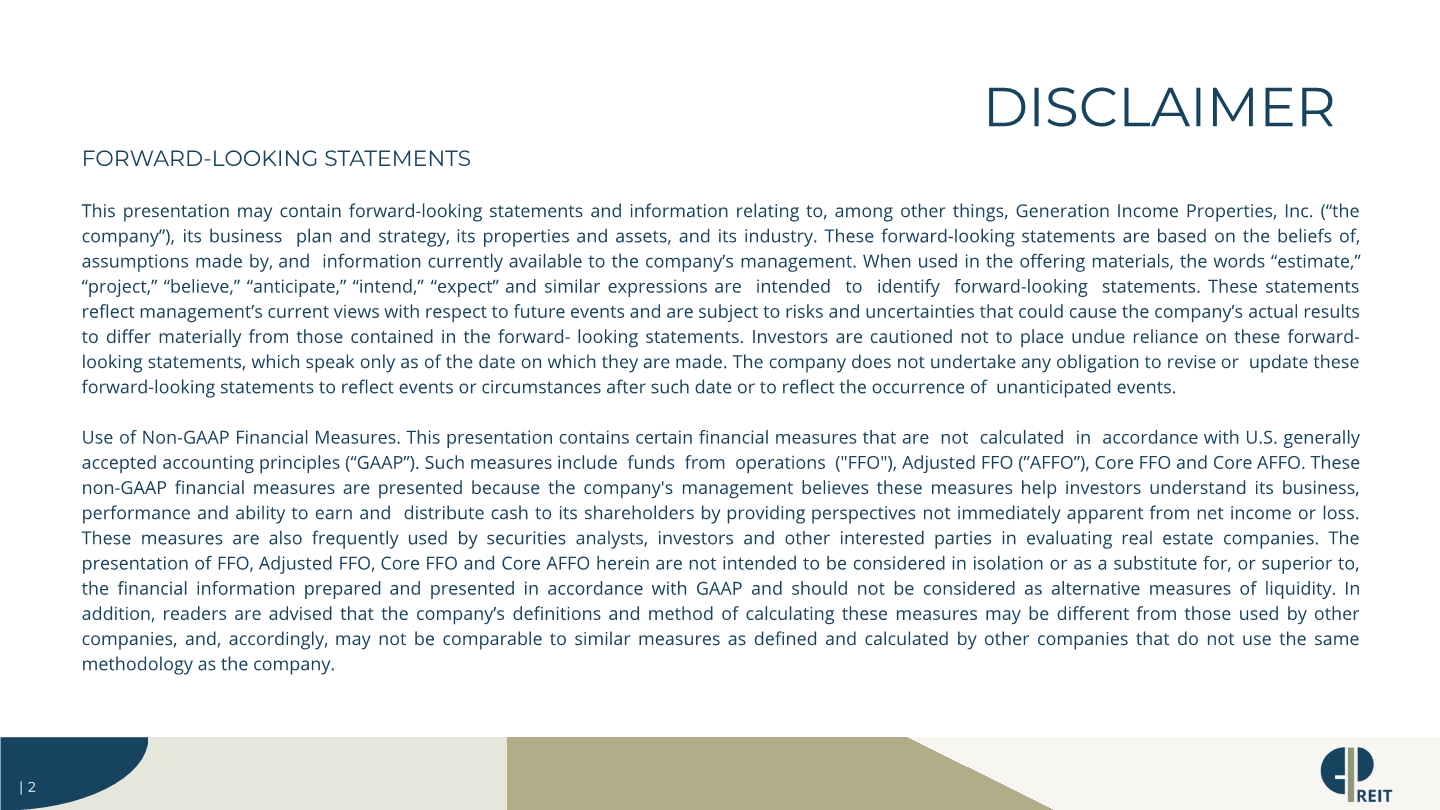
FORWARD-LOOKING STATEMENTS This presentation may contain forward-looking statements and information relating to, among other things, Generation Income Properties, Inc. (“the company”), its business plan and strategy, its properties and assets, and its industry. These forward-looking statements are based on the beliefs of, assumptions made by, and information currently available to the company’s management. When used in the offering materials, the words “estimate,” “project,” “believe,” “anticipate,” “intend,” “expect” and similar expressions are intended to identify forward-looking statements. These statements reflect management’s current views with respect to future events and are subject to risks and uncertainties that could cause the company’s actual results to differ materially from those contained in the forward- looking statements. Investors are cautioned not to place undue reliance on these forward-looking statements, which speak only as of the date on which they are made. The company does not undertake any obligation to revise or update these forward-looking statements to reflect events or circumstances after such date or to reflect the occurrence of unanticipated events. Use of Non-GAAP Financial Measures. This presentation contains certain financial measures that are not calculated in accordance with U.S. generally accepted accounting principles (“GAAP”). Such measures include funds from operations ("FFO"), Adjusted FFO (”AFFO”), Core FFO and Core AFFO. These non-GAAP financial measures are presented because the company's management believes these measures help investors understand its business, performance and ability to earn and distribute cash to its shareholders by providing perspectives not immediately apparent from net income or loss. These measures are also frequently used by securities analysts, investors and other interested parties in evaluating real estate companies. The presentation of FFO, Adjusted FFO, Core FFO and Core AFFO herein are not intended to be considered in isolation or as a substitute for, or superior to, the financial information prepared and presented in accordance with GAAP and should not be considered as alternative measures of liquidity. In addition, readers are advised that the company’s definitions and method of calculating these measures may be different from those used by other companies, and, accordingly, may not be comparable to similar measures as defined and calculated by other companies that do not use the same methodology as the company. DISCLAIMER | 2
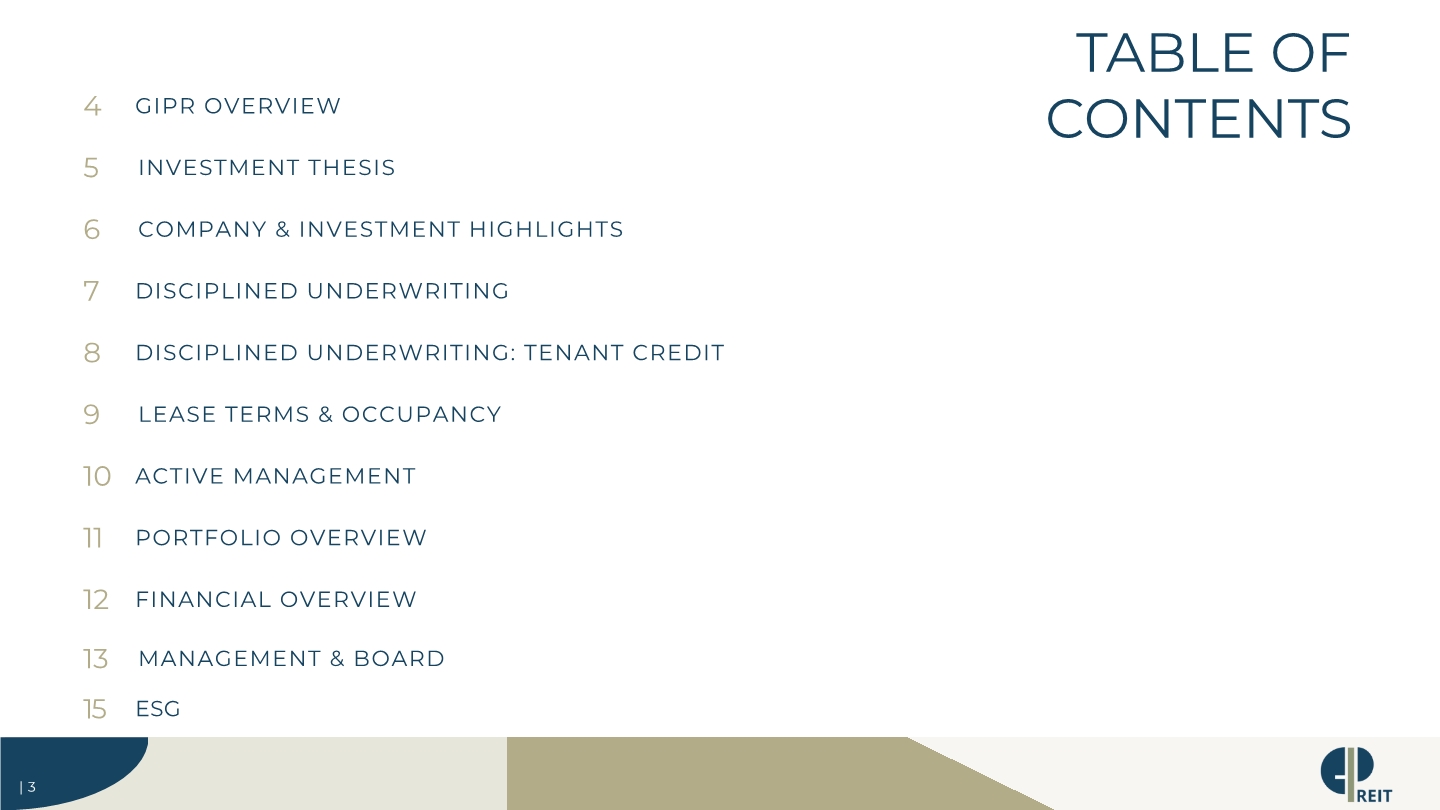
13 Properties TABLE OF CONTENTS 4 5 6 7 8 9 10 11 12 13 15 GIPR OVERVIEW INVESTMENT THESIS COMPANY & INVESTMENT HIGHLIGHTS DISCIPLINED UNDERWRITING DISCIPLINED UNDERWRITING: TENANT CREDIT LEASE TERMS & OCCUPANCY ACTIVE MANAGEMENT PORTFOLIO OVERVIEW FINANCIAL OVERVIEW MANAGEMENT & BOARD ESG | 3
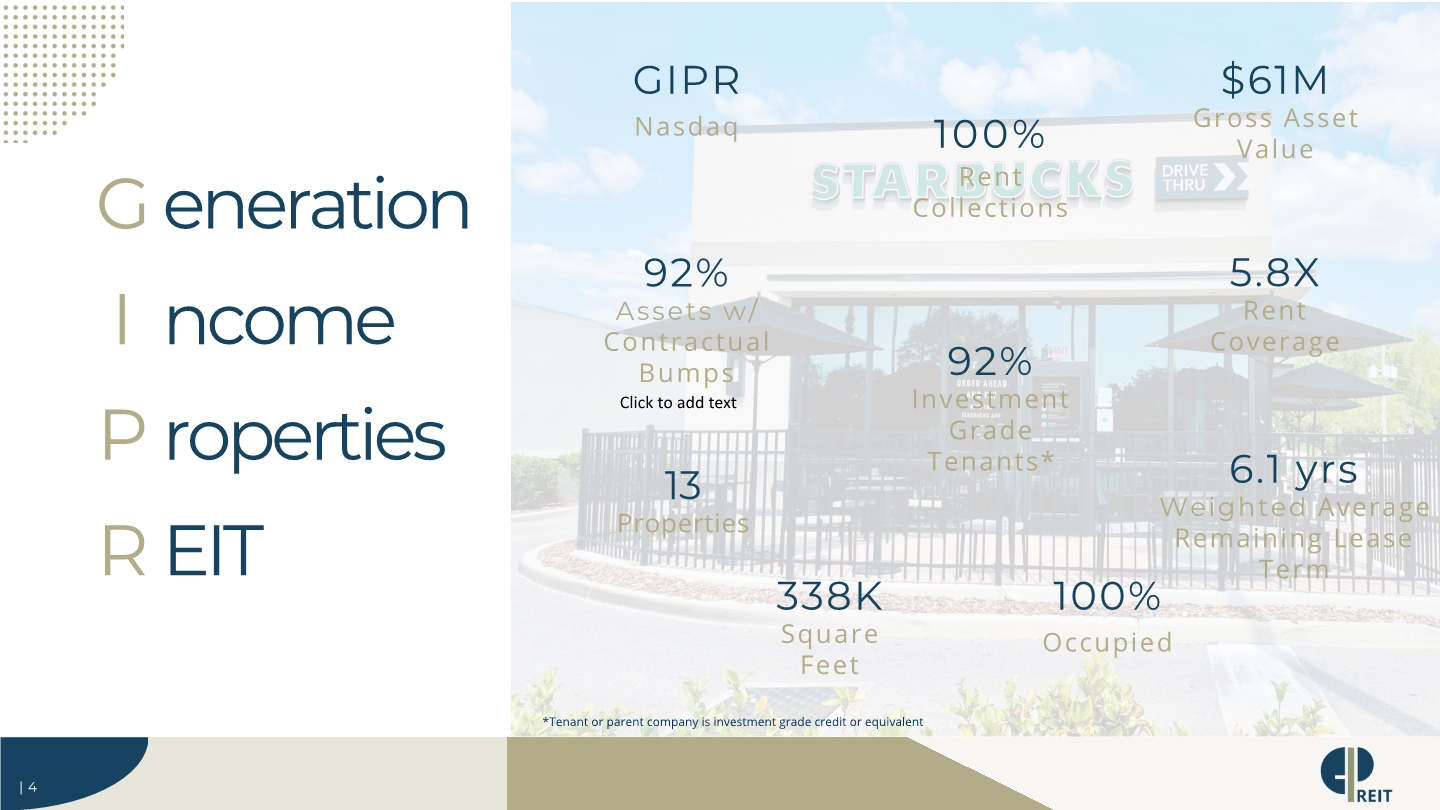
100% Occupied 92% Assets w/ Contractual Bumps 92% Investment Grade Tenants* GIPR Nasdaq 6.1 yrs Weighted Average Remaining Lease Term $61M Gross Asset Value 13 Properties 338K Square Feet 5.8X Rent Coverage | 4 100% Rent Collections *Tenant or parent company is investment grade credit or equivalent Click to add text

INVESTMENT THESIS DISCIPLINED UNDERWRITING Focused on high quality real estate, tenant credit, site-specific performance and geographic attributes. 3 OPPORTUNISTIC LEASE TERMS & CONSISTENT OCCUPANCY Acquiring assets with less than 10 years remaining on lease term in higher density markets with a high likelihood of renewing leases or re-tenanting in a short period following a potential vacancy. 2 STRONG TENANT CREDIT Academic research-based focus on investment grade credit tenants with strong corporate financial metrics. 1 ACTIVE MANAGEMENT Creating strong relationships with each tenant at the corporate and property level, to glean site specific performance and improve the profitability of long-term, consistent occupancy. 4 INTERNAL GROWTH 5 Platform poised for advantageous internal growth through lease renewals, rental increases, re-tenancy and/or asset appreciation. | 5
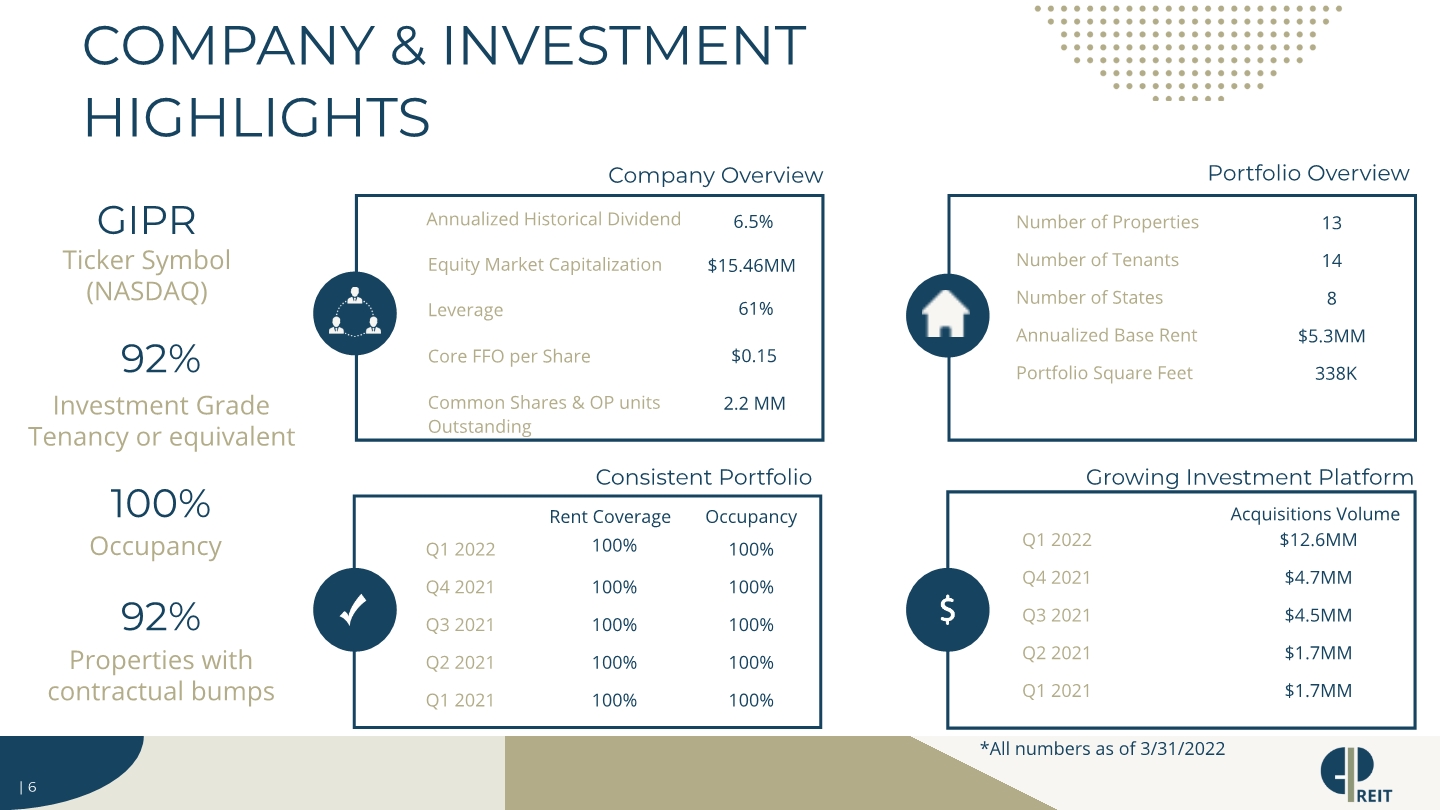
Consistent Portfolio COMPANY & INVESTMENT HIGHLIGHTS Investment Grade Tenancy or equivalent 92% 100% Occupancy 92% GIPR Ticker Symbol (NASDAQ) Properties with contractual bumps $1.7MM Q1 2022 Q4 2021 Q3 2021 Q2 2021 Growing Investment Platform Q1 2021 $1.7MM $4.5MM $4.7MM $12.6MM Acquisitions Volume 100% Q1 2022 Q4 2021 Q3 2021 Q2 2021 Q1 2021 100% 100% 100% 100% 100% 100% 100% 100% Rent Coverage Occupancy Portfolio Overview Company Overview Number of Properties Portfolio Square Feet Number of States Annualized Base Rent Number of Tenants 8 14 13 $5.3MM 338K Annualized Historical Dividend Core FFO per Share Leverage Equity Market Capitalization 61% $15.46MM 6.5% Common Shares & OP units Outstanding 2.2 MM $0.15 100% | 6 *All numbers as of 3/31/2022
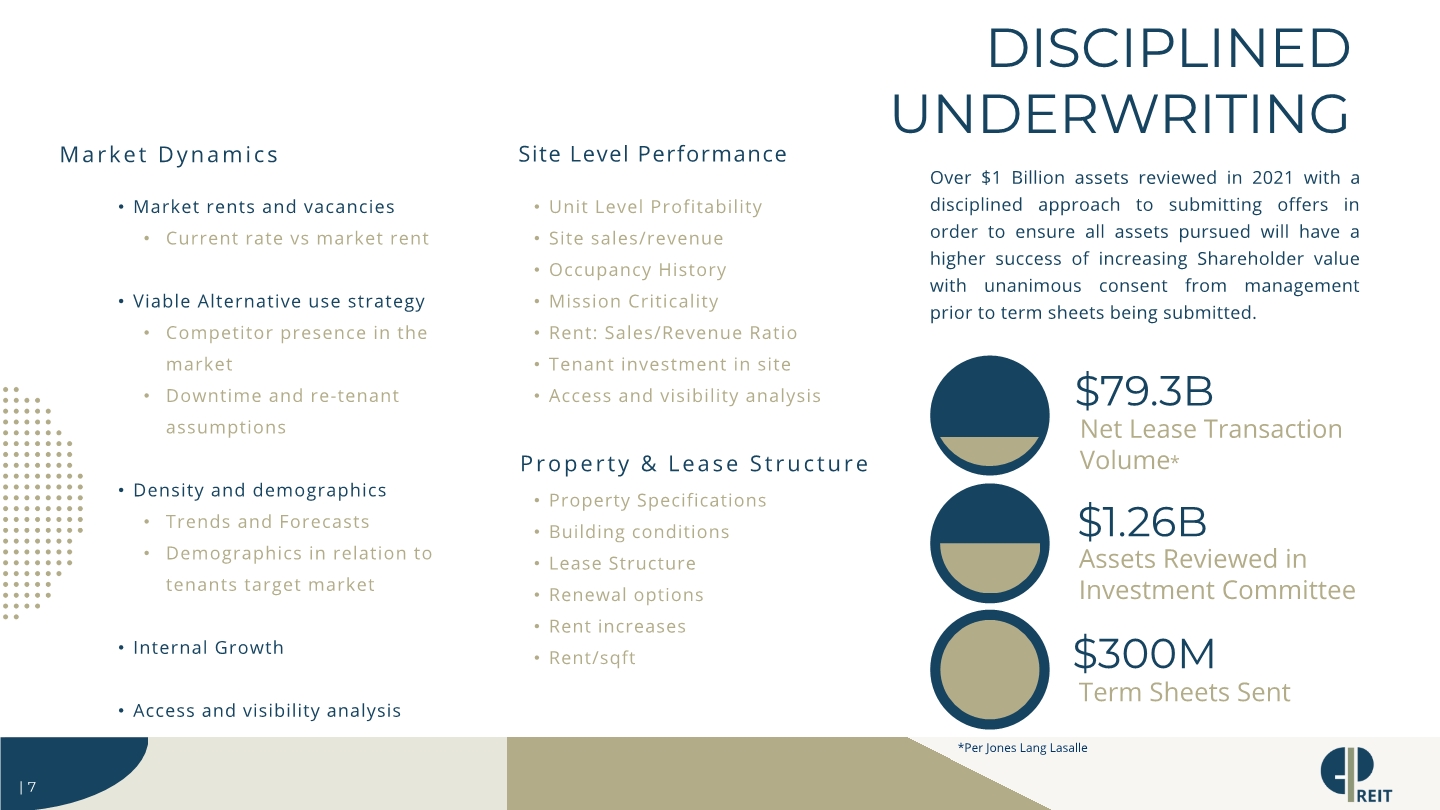
DISCIPLINED UNDERWRITING | 7 Over $1 Billion assets reviewed in 2021 with a disciplined approach to submitting offers in order to ensure all assets pursued will have a higher success of increasing Shareholder value with unanimous consent from management prior to term sheets being submitted. Market Dynamics Market rents and vacancies Current rate vs market rent Viable Alternative use strategy Competitor presence in the market Downtime and re-tenant assumptions Density and demographics Trends and Forecasts Demographics in relation to tenants target market Internal Growth Access and visibility analysis Site Level Performance Unit Level Profitability Site sales/revenue Occupancy History Mission Criticality Rent: Sales/Revenue Ratio Tenant investment in site Access and visibility analysis Property & Lease Structure Property Specifications Building conditions Lease Structure Renewal options Rent increases Rent/sqft $79.3B $1.26B $300M Net Lease Transaction Volume* Assets Reviewed in Investment Committee Term Sheets Sent *Per Jones Lang Lasalle
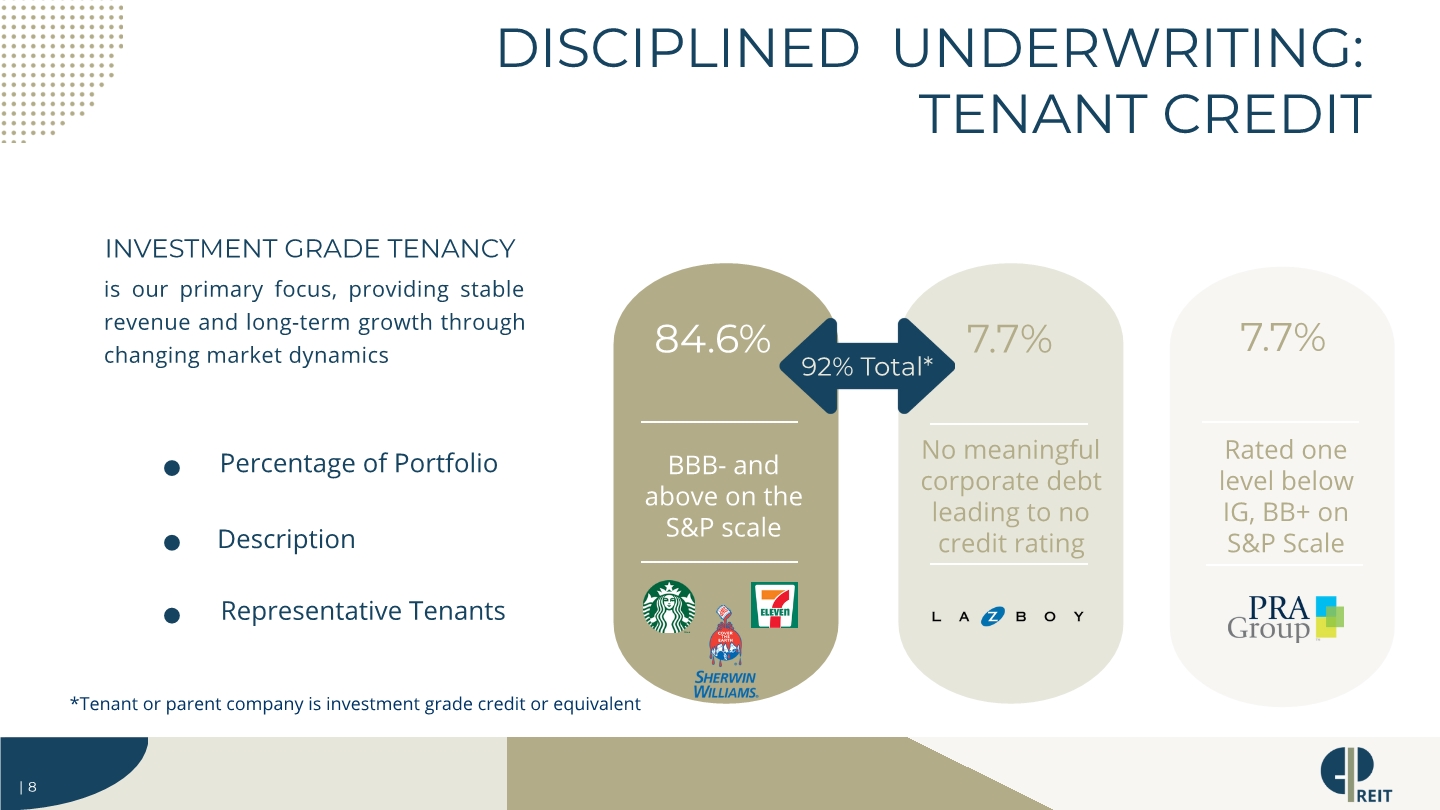
84.6% is our primary focus, providing stable revenue and long-term growth through changing market dynamics | 8 DISCIPLINED UNDERWRITING: TENANT CREDIT No meaningful corporate debt leading to no credit rating 84.6% BBB- and above on the S&P scale 7.7% 7.7% Rated one level below IG, BB+ on S&P Scale 92% Total* Percentage of Portfolio Description Representative Tenants INVESTMENT GRADE TENANCY *Tenant or parent company is investment grade credit or equivalent
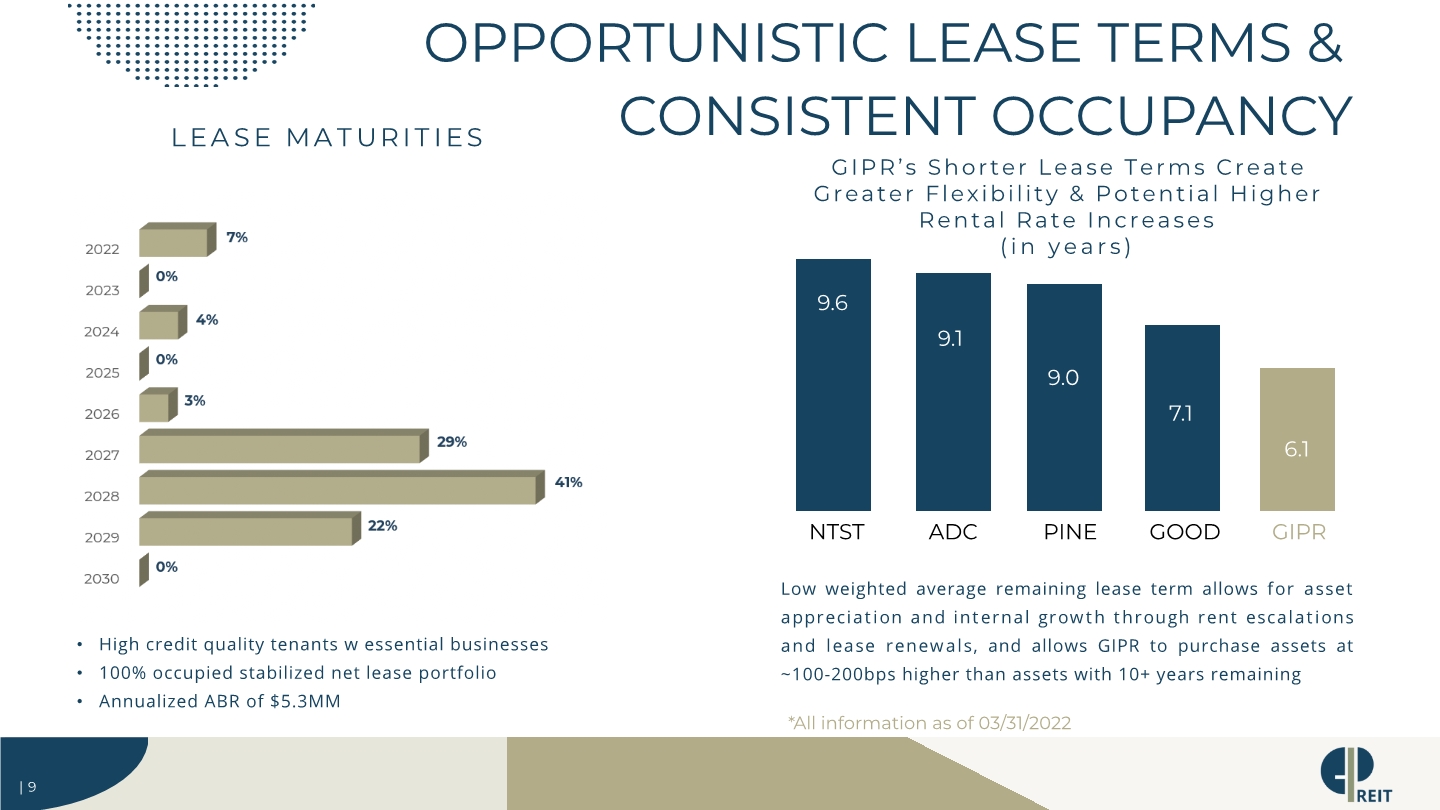
OPPORTUNISTIC LEASE TERMS & CONSISTENT OCCUPANCY GIPR’s Shorter Lease Terms Create Greater Flexibility & Potential Higher Rental Rate Increases (in years) Low weighted average remaining lease term allows for asset appreciation and internal growth through rent escalations and lease renewals, and allows GIPR to purchase assets at ~100-200bps higher than assets with 10+ years remaining High credit quality tenants w essential businesses 100% occupied stabilized net lease portfolio Annualized ABR of $5.3MM | 9 LEASE MATURITIES *All information as of 03/31/2022
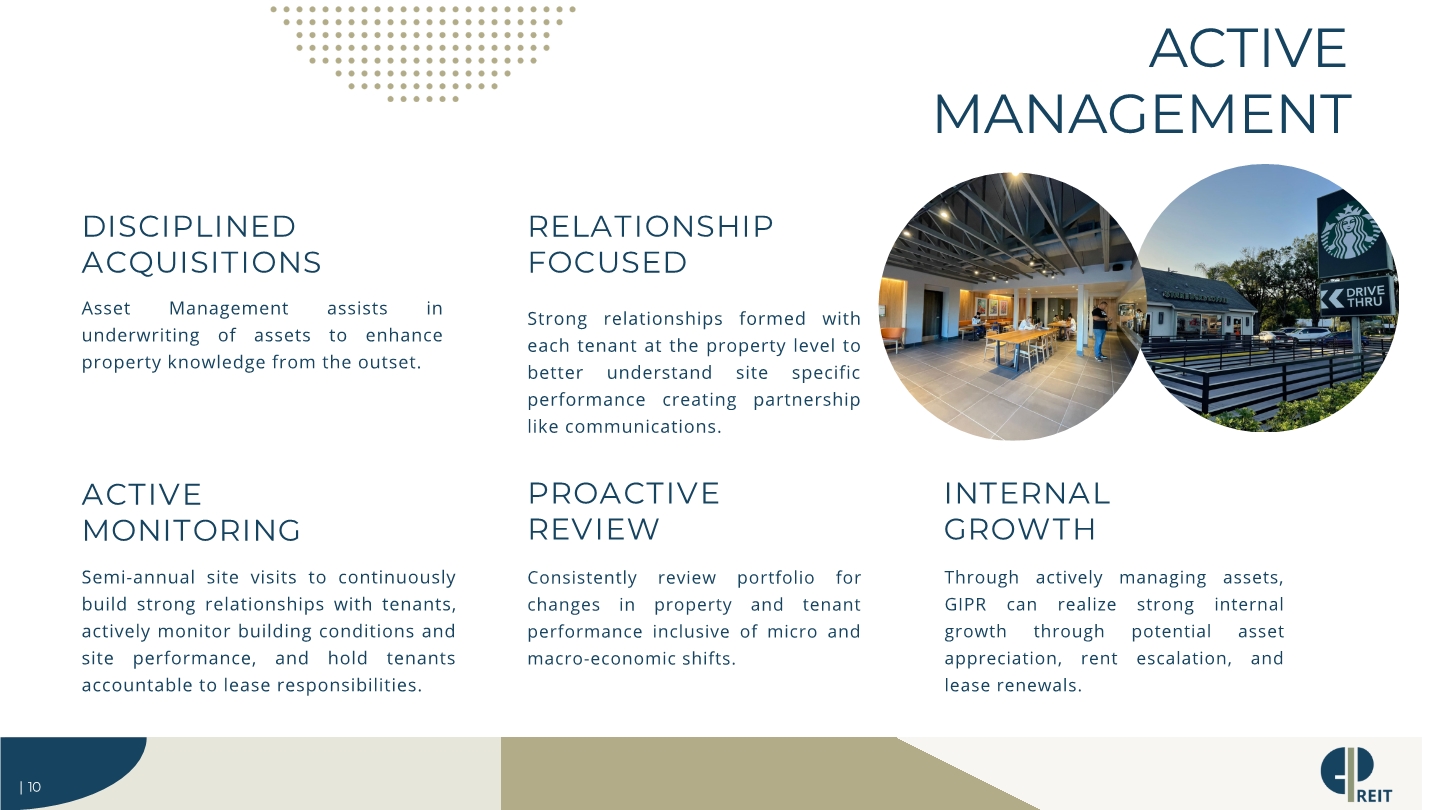
ACTIVE MANAGEMENT | 10 DISCIPLINED ACQUISITIONS RELATIONSHIP FOCUSED Asset Management assists in underwriting of assets to enhance property knowledge from the outset. Strong relationships formed with each tenant at the property level to better understand site specific performance creating partnership like communications. INTERNAL GROWTH ACTIVE MONITORING PROACTIVE REVIEW Semi-annual site visits to continuously build strong relationships with tenants, actively monitor building conditions and site performance, and hold tenants accountable to lease responsibilities. Consistently review portfolio for changes in property and tenant performance inclusive of micro and macro-economic shifts. Through actively managing assets, GIPR can realize strong internal growth through potential asset appreciation, rent escalation, and lease renewals.
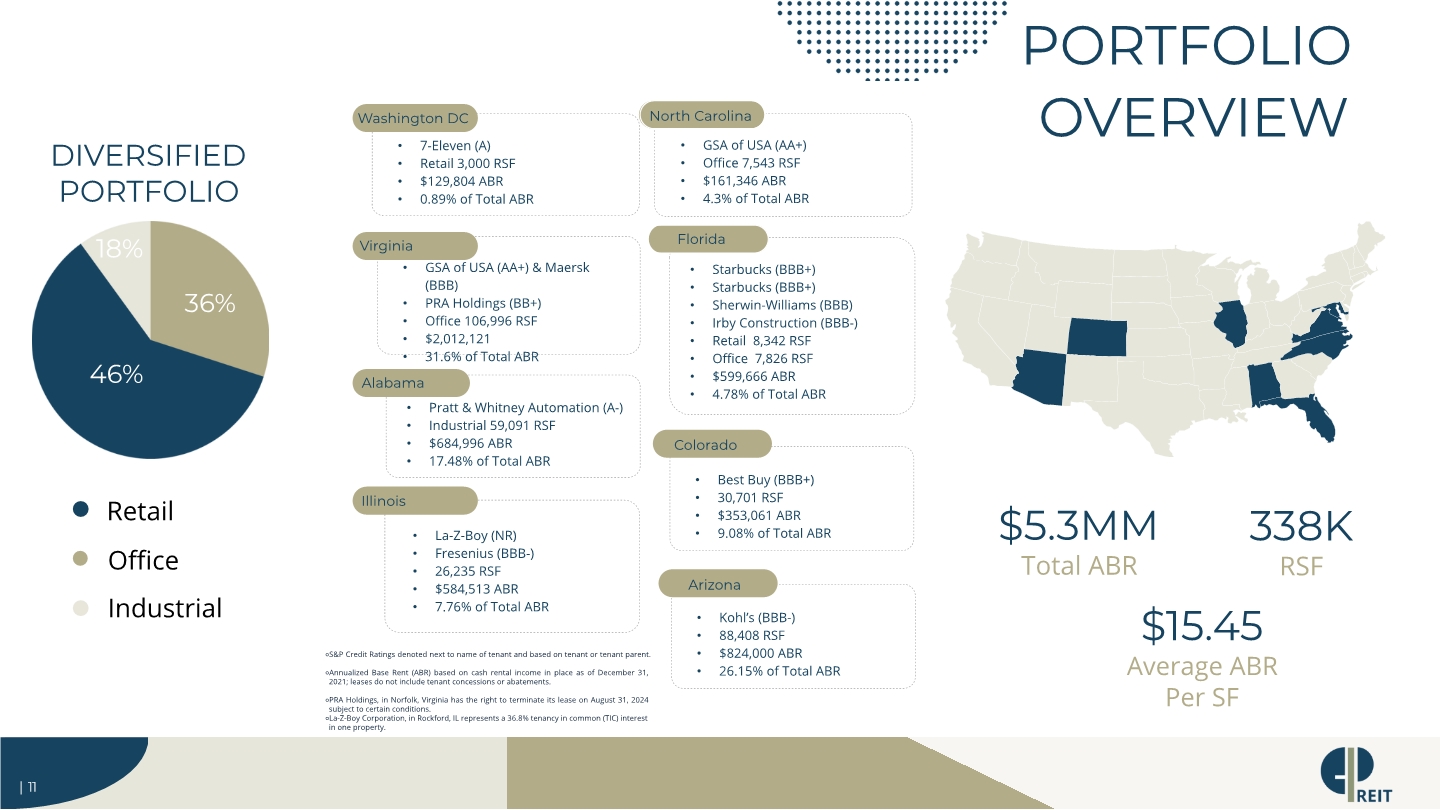
Virginia GSA of USA (AA+) & Maersk (BBB) PRA Holdings (BB+) Office 106,996 RSF $2,012,121 31.6% of Total ABR Washington DC 7-Eleven (A) Retail 3,000 RSF $129,804 ABR 0.89% of Total ABR Florida Starbucks (BBB+) Starbucks (BBB+) Sherwin-Williams (BBB) Irby Construction (BBB-) Retail 8,342 RSF Office 7,826 RSF $599,666 ABR 4.78% of Total ABR Alabama Pratt & Whitney Automation (A-) Industrial 59,091 RSF $684,996 ABR 17.48% of Total ABR North Carolina GSA of USA (AA+) Office 7,543 RSF $161,346 ABR 4.3% of Total ABR Colorado Best Buy (BBB+) 30,701 RSF $353,061 ABR 9.08% of Total ABR Illinois La-Z-Boy (NR) Fresenius (BBB-) 26,235 RSF $584,513 ABR 7.76% of Total ABR S&P Credit Ratings denoted next to name of tenant and based on tenant or tenant parent. Annualized Base Rent (ABR) based on cash rental income in place as of December 31, 2021; leases do not include tenant concessions or abatements. PRA Holdings, in Norfolk, Virginia has the right to terminate its lease on August 31, 2024 subject to certain conditions. La-Z-Boy Corporation, in Rockford, IL represents a 36.8% tenancy in common (TIC) interest in one property. Arizona Kohl’s (BBB-) 88,408 RSF $824,000 ABR 26.15% of Total ABR | 11 $5.3MM Total ABR 338K RSF $15.45 Average ABR Per SF PORTFOLIO OVERVIEW DIVERSIFIED PORTFOLIO 46% 36% 18% Retail Office Industrial
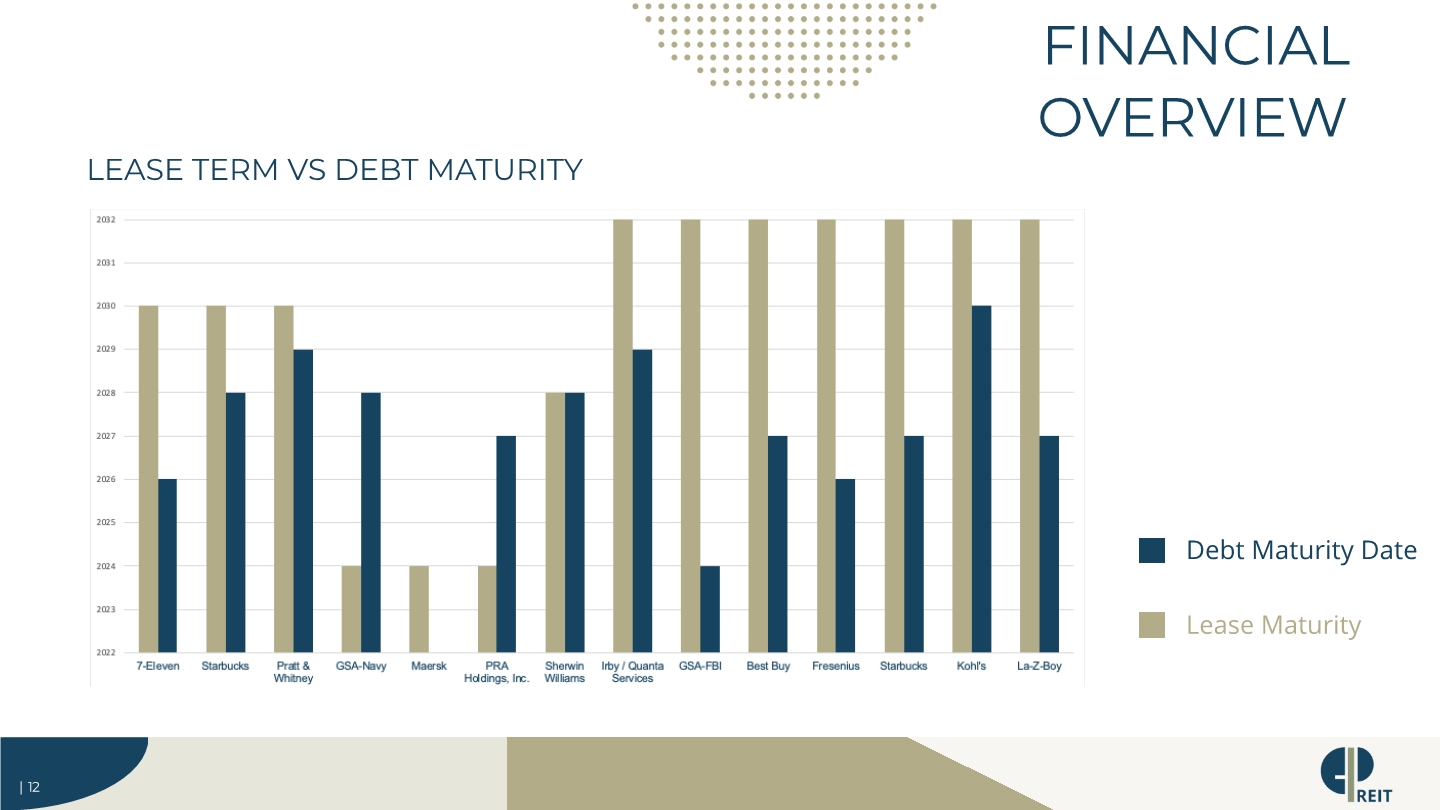
FINANCIAL OVERVIEW | 12 LEASE TERM VS DEBT MATURITY Debt Maturity Date Lease Maturity
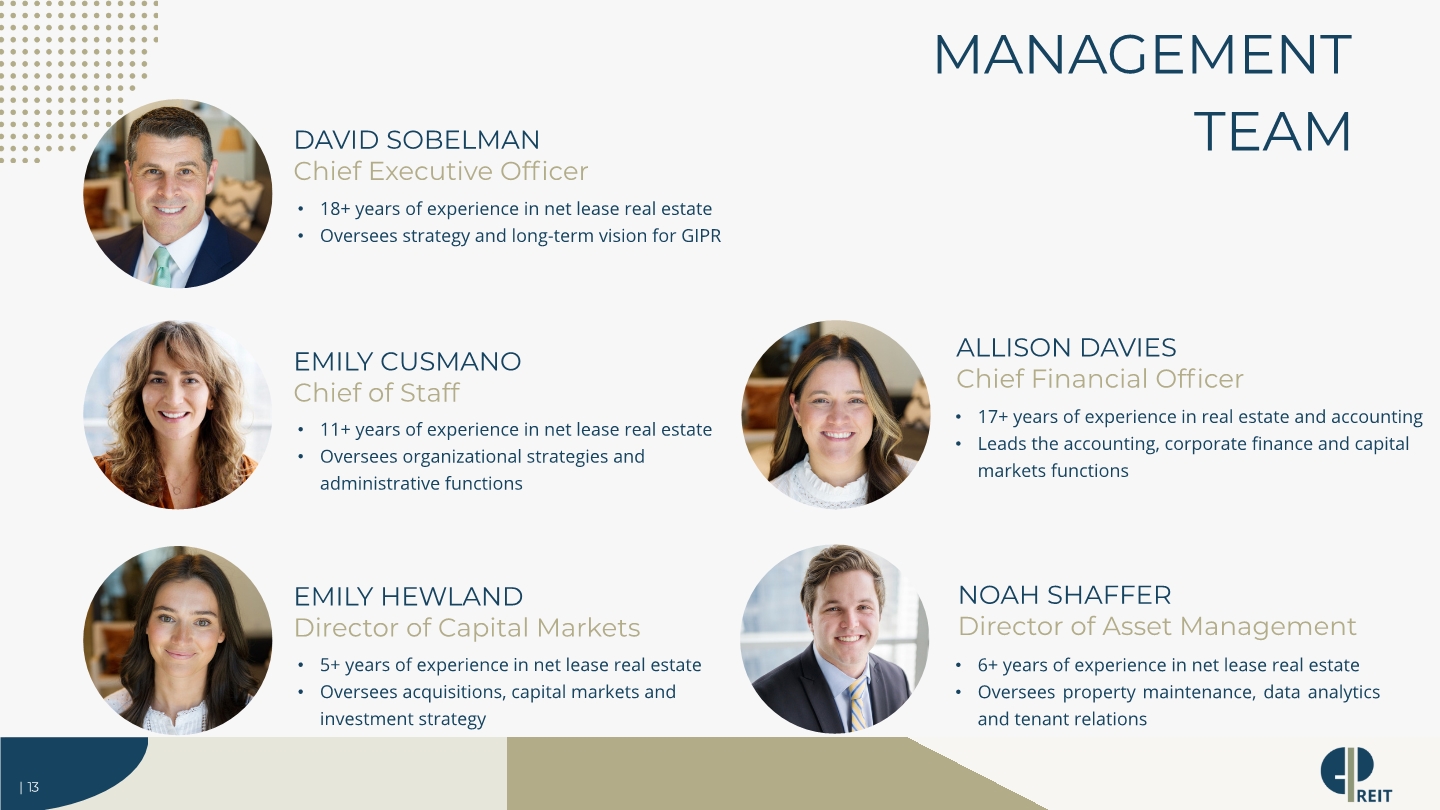
04 02 MANAGEMENT TEAM DAVID SOBELMAN Chief Executive Officer 18+ years of experience in net lease real estate Oversees strategy and long-term vision for GIPR EMILY CUSMANO Chief of Staff 11+ years of experience in net lease real estate Oversees organizational strategies and administrative functions EMILY HEWLAND Director of Capital Markets 5+ years of experience in net lease real estate Oversees acquisitions, capital markets and investment strategy | 13 ALLISON DAVIES Chief Financial Officer 17+ years of experience in real estate and accounting Leads the accounting, corporate finance and capital markets functions NOAH SHAFFER Director of Asset Management 6+ years of experience in net lease real estate Oversees property maintenance, data analytics and tenant relations
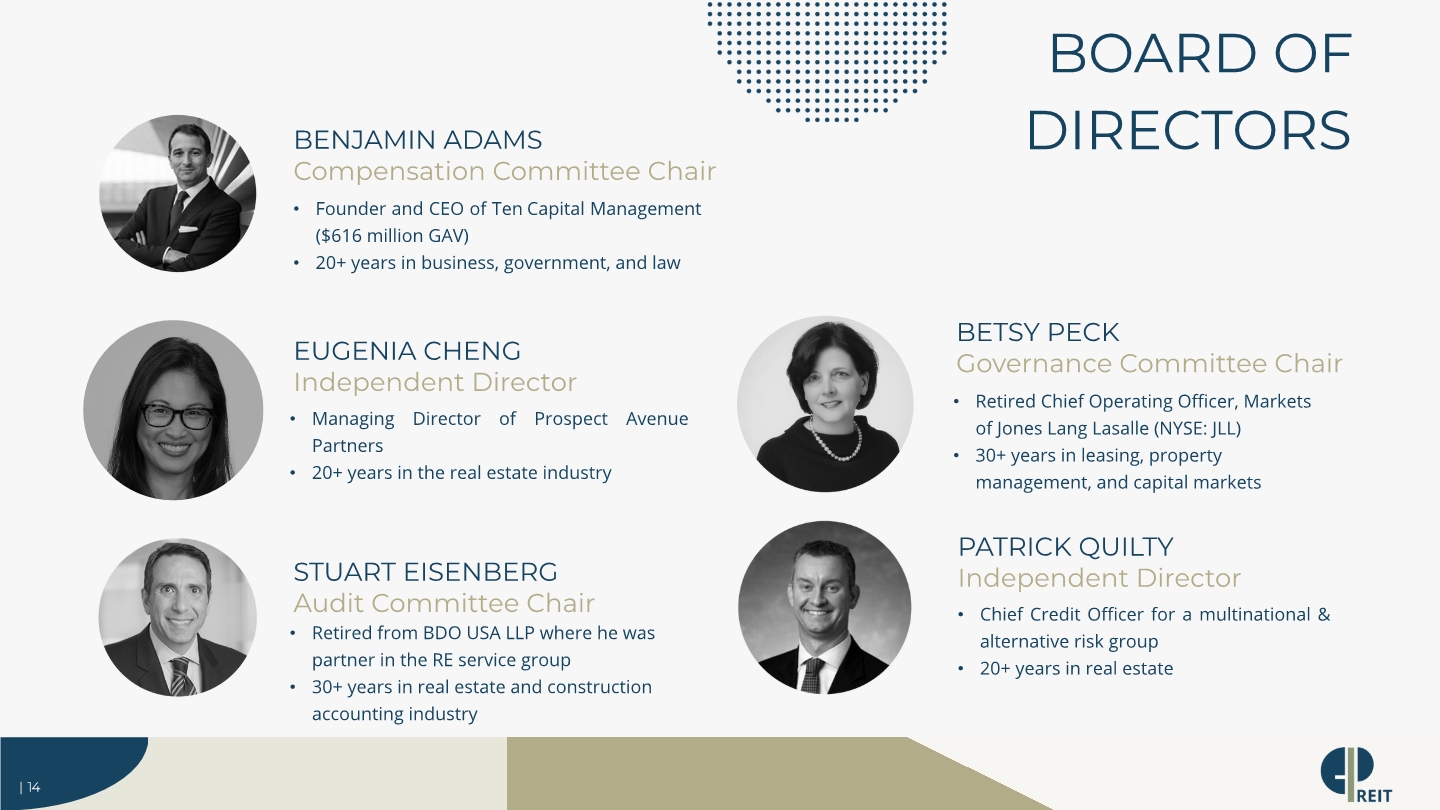
STUART EISENBERG Audit Committee Chair 04 02 BENJAMIN ADAMS Compensation Committee Chair Founder and CEO of Ten Capital Management ($616 million GAV) 20+ years in business, government, and law EUGENIA CHENG Independent Director Managing Director of Prospect Avenue Partners 20+ years in the real estate industry Retired from BDO USA LLP where he was partner in the RE service group 30+ years in real estate and construction accounting industry | 14 BETSY PECK Governance Committee Chair Retired Chief Operating Officer, Markets of Jones Lang Lasalle (NYSE: JLL) 30+ years in leasing, property management, and capital markets PATRICK QUILTY Independent Director Chief Credit Officer for a multinational & alternative risk group 20+ years in real estate BOARD OF DIRECTORS
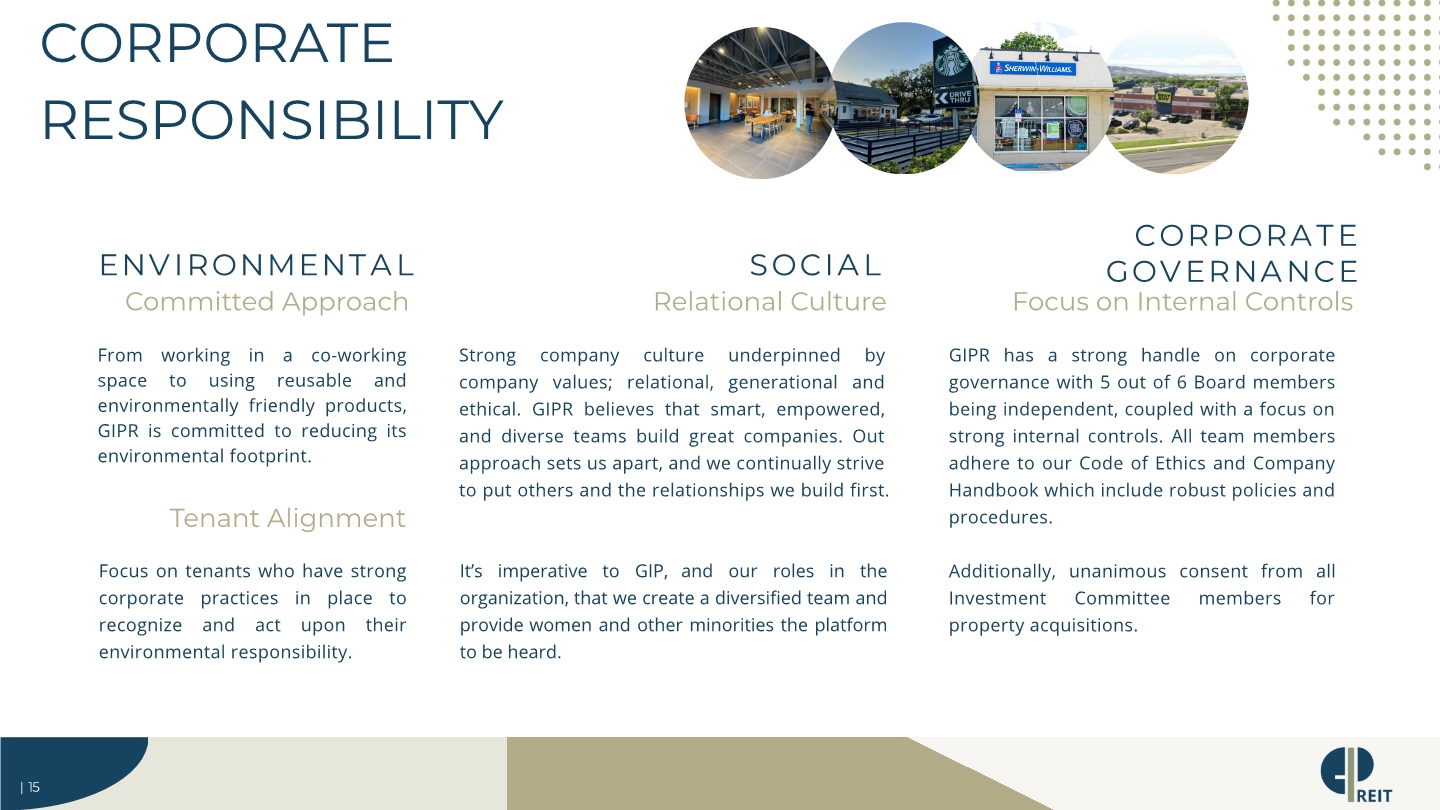
ENVIRONMENTAL SOCIAL CORPORATE GOVERNANCE Committed Approach From working in a co-working space to using reusable and environmentally friendly products, GIPR is committed to reducing its environmental footprint. Tenant Alignment Focus on tenants who have strong corporate practices in place to recognize and act upon their environmental responsibility. Relational Culture Strong company culture underpinned by company values; relational, generational and ethical. GIPR believes that smart, empowered, and diverse teams build great companies. Out approach sets us apart, and we continually strive to put others and the relationships we build first. It’s imperative to GIP, and our roles in the organization, that we create a diversified team and provide women and other minorities the platform to be heard. | 15 CORPORATE RESPONSIBILITY GIPR has a strong handle on corporate governance with 5 out of 6 Board members being independent, coupled with a focus on strong internal controls. All team members adhere to our Code of Ethics and Company Handbook which include robust policies and procedures. Additionally, unanimous consent from all Investment Committee members for property acquisitions. Focus on Internal Controls

INVESTOR RELATIONS ir@gipreit.com (813) 448-1234

EXHIBIT: RECONCILIATION OF NON-GAAP MEASURES The following tables reconcile net income (net loss), which we believe is the most comparable GAAP measure, to FFO, Core FFO, AFFO, and Core AFFO: Our reported results are presented in accordance with GAAP. We also disclose funds from operations (FFO), adjusted funds from operations (AFFO), core funds from operations (Core FFO) and core adjusted funds of operations (Core AFFO) all of which are non-GAAP financial measures. We believe these non-GAAP financial measures are useful to investors because they are widely accepted industry measures used by analysts and investors to compare the operating performance of REITs. FFO and related measures do not represent cash generated from operating activities and are not necessarily indicative of cash available to fund cash requirements; accordingly, they should not be considered alternatives to net income as a performance measure or cash flows from operations as reported on our statement of cash flows as a liquidity measure and should be considered in addition to, and not in lieu of, GAAP financial measures. We compute FFO in accordance with the definition adopted by the Board of Governors of the National Association of Real Estate Investment Trusts or NAREIT. NAREIT defines FFO as GAAP net income or loss adjusted to exclude extraordinary items (as defined by GAAP), net gain or loss from sales of depreciable real estate assets, impairment write-downs associated with depreciable real estate assets, and real estate related depreciation and amortization, including the pro rata share of such adjustments of unconsolidated subsidiaries. We then adjust FFO for non-cash revenues and expenses such as amortization of deferred financing costs, above and below market lease intangible amortization, straight line rent, non-cash stock compensation, public company consulting fees, and non-recurring litigation expenses and settlements to calculate Core AFFO. FFO is used by management, investors, and analysts to facilitate meaningful comparisons of operating performance between periods and among our peers primarily because it excludes the effect of real estate depreciation and amortization and net gains on sales, which are based on historical costs and implicitly assume that the value of real estate diminishes predictably over time, rather than fluctuating based on existing market conditions. We believe that AFFO is an additional useful supplemental measure for investors to consider because it will help them to better assess our operating performance without the distortions created by other non-cash revenues or expenses. FFO and AFFO may not be comparable to similarly titled measures employed by other companies. We believe that Core FFO and Core AFFO are useful measures for management and investors because they further remove the effect of non-cash expenses and certain other expenses that are not directly related to real estate operations. We use each as measures of our performance when we formulate corporate goals. Because FFO excludes depreciation and amortization, gains and losses from property dispositions that are available for distribution to stockholders and extraordinary items, it provides a performance measure that, when compared year over year, reflects the impact to operations from trends in occupancy rates, rental rates, operating costs, development activities, general and administrative expenses and interest costs, providing a perspective not immediately apparent from net income. In addition, our management team believes that FFO provides useful information to the investment community about our financial performance when compared to other REITs since FFO is generally recognized as the industry standard for reporting the operations of REITs. However, FFO should not be viewed as an alternative measure of our operating performance since it does not reflect either depreciation and amortization costs or the level of capital expenditures and leasing costs necessary to maintain the operating performance of our properties which could be significant economic costs and could materially impact our results from operations. Additionally, FFO does it reflect distributions paid to redeemable non-controlling interests.